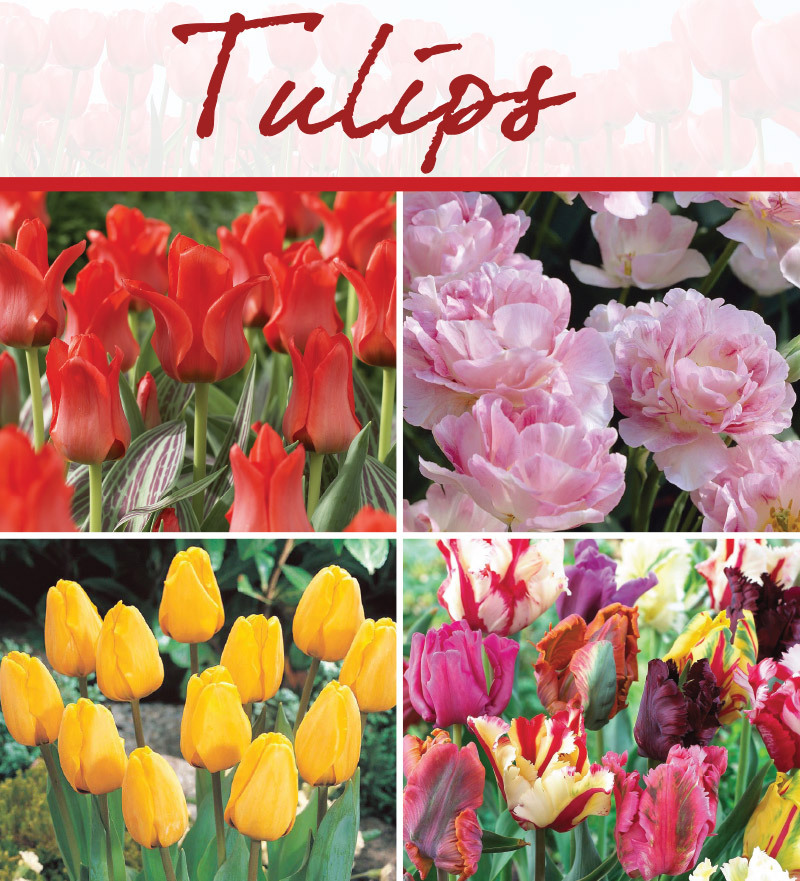I Started a Craze that Gripped the Netherlands
Bulb of the Week: Tulips
The bold, cheerful Tulip is a national symbol of the Netherlands that led to Tulipomania, a famed (and ultimately disastrous) speculative craze also known as Tulip Mania.
A mosaic virus produced exotically variegated Tulips with feathered patterns of two or more colors, and the public could not get enough! The popular desire for these newly-introduced flowers pushed prices to outrageous levels. Tulipomania peaked in early 1637, and then prices bottomed out! Tulips are typically referred to as “Dutch” Tulips but they are believed to originate thousands of years ago in a ‘corridor’ which stretches between Northern China and Southern Europe.
At Rohsler’s, you won’t have to pay extraordinary prices for your Tulips. We have an excellent selection of “Dutch” Tulip bulbs, which will perform in the garden and in containers.
Flower types include single, double, fringed, and Peony-like blooms. We even the stunning variegated forms that spawned Tulipomania. You will find every color under the sun, except for true blue, and varieties that bud and bloom in early spring, mid-spring, and later in the season.With a little advance planning, you will be able to enjoy Tulip blooms for months on end.Choices include everything from the small to the tall. Tulips also make a great cut flower either in a bunch or mixed in an arrangement.
Try the Double Early Mix, which includes bulbs in a range of hues, or Foxtrot, a classic pink Tulip. The single early Hermitage variety produces vibrant orange flowers, while the Purple Queen of the Night sends up deep, dark single blooms. Dallas is a favorite fringed pink Tulip, and the Rembrandt Mixture continues the show into the late season.
Whichever Tulips you choose, remember to stagger your planting (picture a zigzag pattern) for a “full” look in the garden bed. Plant tulips in groupings of at least 10 or more bulbs to have their true colors stand out in the landscape. In general, bulbs should be planted point-up, three times as deep as they are wide, but Tulips in general should be planted approximately eight inches deep.
Of course, Tulips combine well with other bulbs, annuals, and perennials, so consider companion plants when prepping your garden. Planting tulips now in outside containers will bring a cheerful reward in the spring when your container explodes with color.
What You Need to Succeed:
- Bulb-tone, Bone Meal. Add this organic fertilizer to feed your Tulips.
Organic Compost-Bumpercrop. This product will enrich your soil, add beneficial microbes and help with moisture retention. - Crab shells. This product works like magic to convince pesky animals to keep their paws to themselves – and off of your bulbs.
- Organic Mulch (SweetPeet or Root Mulch). Adding one inch of mulch on top of the soil where your bulbs have been planted will help moderate the soil temperatures while bulbs are rooting in, help retain moisture, add nutrients and suppress weeds from growing.
- Repellex. A proper does of this capsacin-based soil additive will keep beasts from feasting on your flowers. Your Tulips will absorb the very substance that gives peppers their heat, making them distasteful to would-be snackers.
- Deer Out/Liquid Fence. Think of these repellents as added insurance that will protect your flowers as the leaves and buds begin to emerge.
More tips await you here at Rohsler’s. Come in today to learn more about how to add these steadfast perennial bulbs to your garden.

